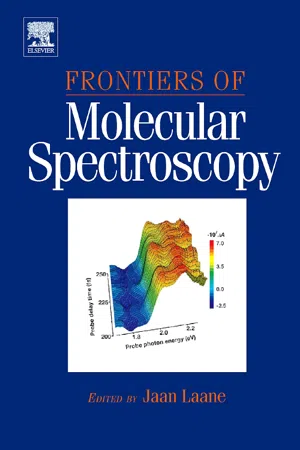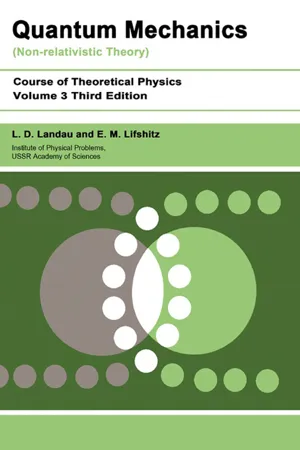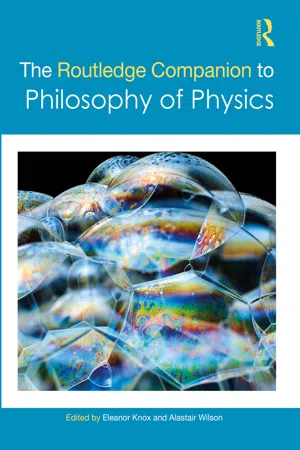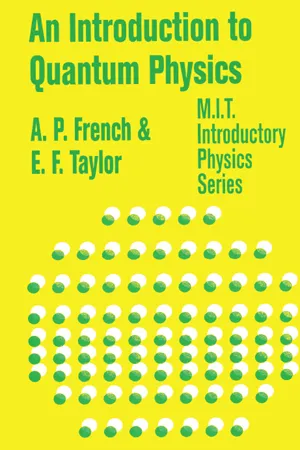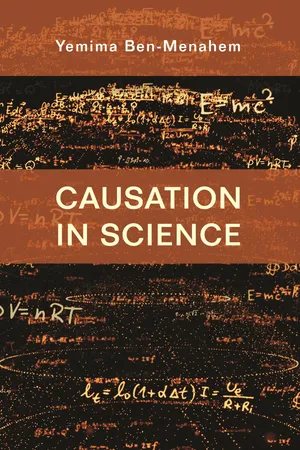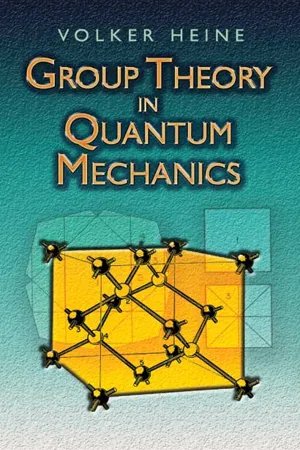Physics
Symmetrization Postulate
The Symmetrization Postulate is a fundamental principle in quantum mechanics that states that the wave function of a system of identical particles must be either symmetric or antisymmetric under the exchange of any two particles. This postulate is essential for understanding the behavior of particles at the quantum level and has important implications for the properties of matter.
Written by Perlego with AI-assistance
Related key terms
Related key terms
1 of 4
Related key terms
1 of 3
7 Key excerpts on "Symmetrization Postulate"
- eBook - ePub
- Jaan Laane(Author)
- 2011(Publication Date)
- Elsevier Science(Publisher)
The Symmetrization Postulate In the Standard Model of theoretical physics, electrons are fundamental particles and they are identical to each other. This means that for an atom or a molecule any permutation of the space and spin coordinates of the electrons commutes with the Hamiltonian and is therefore a symmetry operation. For a system containing n electrons, the symmetry group of all possible n ! electron permutations is called the symmetric group and is denoted S n [10]. The class structure of a symmetric group is easy to determine because all permutations of the same shape (i.e., consisting of the same number of independent transpositions, independent cycles of three, independent cycles of four, etc.) are in the same class. For example, in the group S 5 there are seven classes, and the elements in these classes have the following shapes: (1) The number of classes in the symmetric group S n is given by the partition number of n, i.e., the number of ways of writing n as the sum of integers. For example, for n = 5 we can write (2) so that the partition number of 5 is 7. The parallel between this partitioning of the number 5 and the shapes of the permutations in each class in Equation (1) is obvious. Because the number of irreducible representations in a group is equal to the number of classes, we can immediately deduce the number of irreducible representations in S n once we have the partition number of n. For example, the group S 5 has seven irreducible representations; the character table of the symmetric group S 5 is given in Table 1. Table 1. The character table [ a ] of the symmetric. group S 5 E (12) (12)(34) (123) (12)(345) (1234) (12345) 1 10 15 20 20 30 24 D (0) : 1 1 1 1 1 1 1 : 1 −1 1 1 −1 −1 1 D (1) : 4 2 0 1 −1 0 −1 : 4 −2 0 1 1 0 −1 D (2) : 5 1 1 −1 1 −1 0 : 5 −1 1 −1 −1 1 0 D ¯ (3) = : 6 0 −2 0[--=PLGO-SEPARATOR - eBook - ePub
Quantum Mechanics
Non-Relativistic Theory
- L D Landau, E.M. Lifshitz(Authors)
- 1981(Publication Date)
- Butterworth-Heinemann(Publisher)
2 conventionally denoting the three coordinates and the spin projection for each particle. Then we must havewhere α is some real constant. By repeating the interchange, we return to the original state, while the function ψ is multiplied by e2i α. Hence it follows that e2i α= 1, or ei α= ± 1. ThusWe thus reach the result that there are only two possibilities: the wave function is either symmetrical (i.e. it is unchanged when the particles are interchanged) or antisymmetrical (i.e. it changes sign when this interchange is made). It is obvious that the wave functions of all the states of a given system must have the same symmetry; otherwise, the wave function of a state which was a superposition of states of different symmetry would be neither symmetrical nor antisymmetrical.This result can be immediately generalized to systems consisting of any number of identical particles. For it is clear from the identity of the particles that, if any pair of them has the property of being described by, say, symmetrical wave functions, any other pair of such particles has the same property. Hence the wave function of identical particles must either be unchanged when any pair of particles are interchanged (and hence when the particles are permuted in any manner), or change sign when any pair are interchanged. In the first case we speak of a symmetrical wave function, and in the second case of an antisymmetrical one.The property of being described by symmetrical or antisymmetrical wave functions depends on the nature of the particles. Particles described by antisymmetrical functions are said to obey Fermi–Dirac statistics (or to be fermions ), while those which are described by symmetrical functions are said to obey Bose-Einstein statistics (or to be bosons ).† - eBook - ePub
- Eleanor Knox, Alastair Wilson, Eleanor Knox, Alastair Wilson(Authors)
- 2021(Publication Date)
- Routledge(Publisher)
λ .The restriction to either the bosonic sectorH + Nor the fermionic sectorH - Nis widely known as the Symmetrization Postulate . All evidence so far suggests that the postulate is true, though there is an interesting history here. Before the acceptance of quark color, it had been proposed, chiefly by O. W. Greenberg, that quarks might be paraparticles. (For more, see French, 1995 .) We now believe quarks to be fermions, but this raises the general question why paraparticles, perfectly allowed under permutation invarance, are not found in nature. Dürr et al. (2007) make the case that de Broglie-Bohm theory may have the edge over its rivals here, since the requirement that corpuscle trajectories be determinate appears to rule out multi-dimensional irreps of S N . Baker et al. (2015) point to a result in the framework of algebraic quantum field theory, that any local quantum field exhibiting paraparticle statistics is equivalent to one with bosonic or fermionic statistics plus a new internal degree of freedom with accompanying constraints; they argue on the basis of this that the issue of particle statistics may be a matter of mere convention, rendering the Symmetrization Postulate more a decision than a discovery.The fact that, for bosons and fermions, the i.i.s.s under the lifted permutations are all 1-dimensional means that we have here a case where haecceitism and anti-haecceitism trivially agree: for these joint states are fixed (up to global phase) by any lifted permutation. It is commonly claimed of these states that they represent particles which are indiscernible by means of monadic properties, i.e., absolutely indiscernible. In fact this is the wide consensus in the quantum identity literature. (The consensus began with Margenau (1944) and continued with Post (1963) , French and Redhead (1988) , van Fraassen (1991 , Ch. 11 ), Butterfield (1993) , Saunders (2003a , 2003b , 2006a ), French and Krause (2006 , §4.2.1), Muller and Saunders (2008) , Muller and Seevinck (2009) , Ladyman and Bigaj (2010) , Caulton (2012) and Huggett and Norton (2012).) However, this conclusion can be reached only on the assumption that the particles in question are denoted by the order of the factor Hilbert spaces in the tensor productℋN, so that a permutation of the factor Hilbert spaces under each U (π ) is taken to correspond to a permutation of the particles. This is tantamount to a commitment to transcendental individuality, as defined in Section 41.3.2 . A proponent of qualitative individuality would contend rather that the lifted permutations U (π ) correspond to no real permutation at all. Proposals along the lines of qualitative individuality may be found in Huggett and Imbo (2009) , Dieks and Lubberdink (2011) and Earman (2015) - eBook - ePub
- A.P. French(Author)
- 2018(Publication Date)
- Routledge(Publisher)
In practice, however, it will often be unnecessary (as well as impracticable) to apply the symmetry condition explicitly. Consider, for example, two separate hydrogen atoms, both in their ground state. Then, strictly speaking, we ought to construct for this system a total wave function that is antisymmetric with respect to exchange of the two electrons (and of the two protons also). However, it is intuitively more or less obvious that if the atoms are widely separated (by more than a few angstroms), they act as entirely independent systems. The fact that each electron is in the same quantum state with respect to its own proton is in no sense a violation of the Pauli exclusion principle. On the other hand, if the two atoms are brought so close that they begin to interact (the ultimate result perhaps being the formation of a hydrogen molecule) then the construction of an antisymmetrized wave function is essential to a correct description of the complete system. There is a simple criterion for whether or not the symmetry must be considered. If the individual-particle wave functions overlap significantly, in the sense that there are regions in which both have appreciable magnitude, then the symmetry or antisymmetry is important. If the amount of overlap is negligible, then one can use a simple product wave function that is neither symmetric nor antisymmetric. The formal basis of this criterion can be made apparent if one writes the total space wave function for a system of two particles: ψ (x 1, x 2) = 1 2 [ ψ A (x 1) ψ B (x 2) ± ψ B (x 1) ψ A (x 2) ] Forming from this the probability density, we. have | ψ (x 1, x 2) | 2 = 1 2 | ψ A (x 1) ψ B (x 2) | 2 + 1 2 | ψ B (x 1) ψ A (x 2) | 2 ± { ψ A ∗ (x 1) ψ B (x 1) ψ B ∗ (x 2) ψ A (x 2) + ψ B ∗ (x 1[--=PLGO-S. EPARATOR=--]) ψ A (x 1) ψ A ∗ (x 2) ψ B (x 2) } The term within braces embodies the essential consequence of identity, that each particle must be associated with both of the component wave functions - eBook - ePub
- Yemima Ben-Menahem(Author)
- 2018(Publication Date)
- Princeton University Press(Publisher)
11 To decide between these possibilities, he noted that the symmetric solution puts no limit on the number of electrons in the same orbit. By contrast, an antisymmetric function vanishes when the two electrons occupy the same state, from which it follows that such double occupancy cannot represent a stationary state. The antisymmetric solution is therefore the only one compatible with the Pauli exclusion principle.With these developments, it became clear that the significance of the exclusion principle was far deeper than had been initially recognized. In addition to reconciling the aforementioned discrepancies and accounting for the electron’s spin, the principle came to be seen as a key to understanding the structure of matter in general. A beautiful application was worked out in 1930 by Subrahmanyan Chandrasekhar, who used the exclusion principle to study the evolution of stars whose nuclear fuel has been exhausted. Could such “dead” stars be stable, or were they at some point bound to collapse under their own gravity? Chandrasekhar (1930a; 1931b) argued that in the case of white dwarfs, the dominant factor in balancing the inward gravitational pressure is not thermal pressure but rather the pressure generated by a gas of electrons obeying Pauli’s exclusion principle. The principle dictates that electrons brought closer by gravity are forced into higher energy levels than they would have occupied had they been free to cram together at the lowest energy level. The electrons thus develop higher speed, and as a result, higher pressure (known as electron degeneracy pressure).12 On the basis of relativistic and quantum mechanical considerations, Chandrasekhar calculated how the balance between the gravitational pressure and the electronic pressure could be maintained. He showed that beyond approximately 1.4 solar masses, gravity overtakes the electron degeneracy pressure and the star collapses, turning into what would later be called a black hole. For our purposes, the salient point is that the exclusion principle, by accounting for these interactions and processes, plays an essential role in this calculation. The force that counterbalances gravity is patently as significant a causal factor as gravity itself.13 - eBook - ePub
- Lucjan Piela(Author)
- 2006(Publication Date)
- Elsevier Science(Publisher)
−1 , which you may easily check. The product of two orthogonal matrices represents an orthogonal matrix, therefore any rotation corresponds to an orthogonal matrix.2.1.4 INVARIANCE WITH RESPECT TO PERMUTATION OF IDENTICAL PARTICLES (FERMIONS AND BOSONS)
The Hamiltonian has also permutational symmetry. This means that if someone exchanged labels numbering the identical particles, independently of how it was done, they would always obtain the identical mathematical expression for the Hamiltonian. This implies that any wave function has to be symmetric (for bosons) or antisymmetric (fermions) with respect to the exchange of labels between two identical particles (cf. p. 33 ).2.1.5 INVARIANCE OF THE TOTAL CHARGE
The total electric charge of a system does not change, whatever happens. In addition to the energy, momentum and angular momentum, strict conservation laws are obeyed exclusively for the total electric charge and the baryon and lepton numbers (a given particle contributes +1, the corresponding the antiparticle −1).7 The charge conservation law follows from the gauge symmetry. This symmetry means the invariance of the theory with respect to partition of the total system into subsystems. Total electric charge conservation follows from the fact that the description of the system has to be invariant with respect to the mixing of the particle and antiparticle states, which is analogous to rotation.2.1.6 FUNDAMENTAL AND LESS FUNDAMENTAL INVARIANCES
The conservation laws described are of a fundamental character, because they are related to the homogeneity of space and time, the isotropy of space and the non-distinguishability of identical particles.Besides these strict conservation laws, there are also some approximate laws. Two of these: parity and charge conjugation, will be discussed below. They are rooted in these strict laws, but are valid only in some conditions. For example, in most experiments, not only the baryon number, but also the number of nuclei of each kind are conserved. Despite the importance of this law in chemical reaction equations, this does not represent any strict conservation law as shown by radioactive transmutations of elements. - eBook - ePub
Group Theory in Quantum Mechanics
An Introduction to Its Present Usage
- Volker Heine(Author)
- 2013(Publication Date)
- Dover Publications(Publisher)
Chapter ISYMMETRY TRANSFORMATIONS IN QUANTUM MECHANICS
1. The Uses of Symmetry Properties
Although this book has been titled “Introduction to the Present Use of Group Theory in Quantum Mechanics” in accordance with customary usage, a rather more descriptive title would have been “The Consequences of Symmetry in Quantum Mechanics”. The fact that these symmetry properties form what mathematicians have termed “groups” is really incidental from a physicist’s point of view, though it is vital to the mathematical form of the theory. It is in fact the symmetries of quantum mechanical systems that we shall be interested in.The following three simple examples illustrate in a preliminary way what is meant by symmetry properties and what their main consequences are.(i) It can be shown that the wave functions ψ (r1 , r2 ) (without spin) of a helium atom are of two types, symmetric and anti-symmetric, according to whetherψ (r1 , r2 ) = ψ (r2, ri ) or ψ (r1 , r2 ) = −ψ (r2 , r1 ),where r1 and r2 are the position vectors of the two electrons (Schiff 1955, p. 234). The corresponding states of the atom are also referred to as symmetric and anti-symmetric. Thus the eigenfunctions turn out to have well defined symmetry properties which can therefore be used in classifying and distinguishing all the different eigenstates.(ii) There are three 2p wave functions for a hydrogen atom,(1.1)where f (r ) is a particular function of r = |r| only (Schiff 1955, p. 85). Now in a free atom there are no special directions and we can choose and label the x-, y- and z
Index pages curate the most relevant extracts from our library of academic textbooks. They’ve been created using an in-house natural language model (NLM), each adding context and meaning to key research topics.
Explore more topic indexes
Explore more topic indexes
1 of 6
Explore more topic indexes
1 of 4
